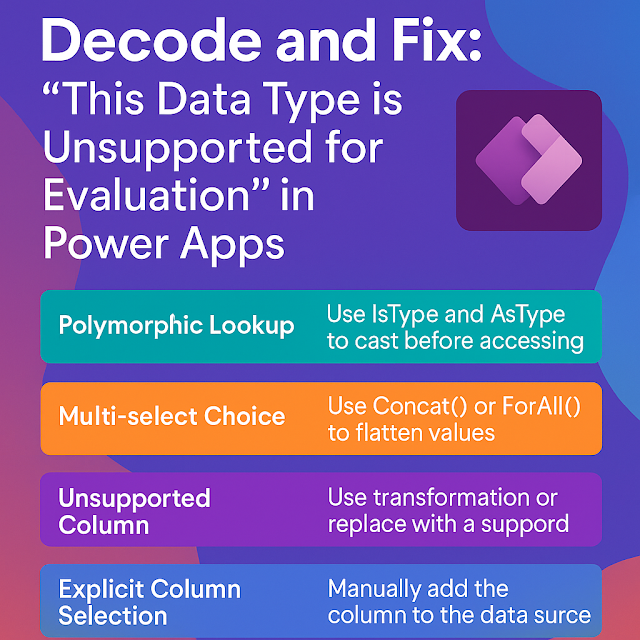Pipeline-First Thinking: Designing Robust Business Logic in Dataverse
In Microsoft Dataverse, every data operation—whether triggered by a form save, API call, plugin, or Power Automate flow—passes through a well-defined execution pipeline. Understanding this pipeline is not just a technical detail; it is the foundation for designing scalable, predictable, and maintainable business logic. This approach is called Pipeline-First Thinking, and it is a mindset every Power Platform architect and senior developer must adopt.
What Is Pipeline-First Thinking?
Pipeline-First Thinking means designing your custom logic based on where and how Dataverse processes your data. Instead of jumping directly into writing plugins or creating Power Automate flows, you first analyze:
- Which stage of the pipeline should run the logic? (Pre-Validation, Pre-Operation, Post-Operation, Async, etc.)
- What data is available at each stage?
- How will the logic behave inside a transaction?
- What are the impacts on performance, validations, and external integrations?
By aligning business rules with the pipeline, you ensure your solution behaves consistently and avoids common pitfalls such as recursion loops, incorrect data updates, and race conditions.
Why Pipeline-First Thinking Matters
1. Ensures Predictable and Stable Behavior
When multiple plugins, flows, or custom APIs act on the same entity, understanding the execution order becomes critical.
Pipeline-First design avoids unexpected overrides, duplicate logic, or conflicting updates.
2. Improves Performance & Scalability
Running heavy logic in synchronous stages increases form load and API response times.
Pipeline-First Thinking moves non-critical operations to:
- Post-Operation Async for long-running processes
- External services for bulk or high-load operations
3. Strengthens Data Quality and Validation
Pre-Operation stages allow data validation before it enters the database.
This means:
- No partial or incorrect data is saved
- Business rules remain centralized and consistent
4. Enhances Integration Reliability
External calls (API, Azure Functions, queues) should run outside the database transaction when possible.
Async Post-Operation ensures retryability without blocking the user.
5. Simplifies Debugging and Maintenance
When logic follows a clear pipeline structure, issues become easier to trace using:
- Plugin Trace Logs
- Operation timestamps
- Correlation IDs
Architects can quickly understand what executed, when, and why.
Pipeline-First Design Principles
Choose the Right Stage
Avoid Putting Everything in Plugins
Pipeline-First Thinking helps choose smarter alternatives:
- Business Rules for UI-level validations
- Power Automate for low-impact automation
- Custom APIs for controlled integration routes
- Webhooks/Azure Functions for scalable external processing
Ensure Transaction Awareness
- Synch plugins run inside a Dataverse transaction.
- If anything fails → the entire operation rolls back.
- Use async pipelines for logic that must not affect record saving.
Prevent Recursion
Pipeline-First design uses:
- Depth checks
- Filtering attributes
- Trigger conditions
to avoid unwanted multiple executions.
Real-World Examples Where Pipeline-First Thinking Helps
1. Validating Customer Blacklist Before Account Creation
- Validate in Pre-Operation → block creation if blacklisted
- Log additional info in Async Post-Operation
2. Generating Custom Numbers
- Pre-Operation → assign IDs before saving
- Avoids collision, ensures transaction consistency
3. Sending Data to External APIs
- Post-Operation Async → avoid blocking user experience
- Retry logic via Azure Service Bus or Logic App
4. Maintaining Calculated Fields
- Pre-Operation → set totals, status values, or hierarchy fields
5. Multi-step Business Processes
- Use a combination of pipeline stages to orchestrate rules cleanly
Conclusion
Pipeline-First Thinking is essential for building stable, performant, and future-proof Dataverse solutions.
It ensures that every customization—plugins, flows, custom APIs, or external integrations—aligns with the natural order of Dataverse operations. By understanding and designing around the execution pipeline, architects can create solutions that scale smoothly, avoid unexpected behavior, and deliver a better experience for users and developers alike.















Comments
Post a Comment